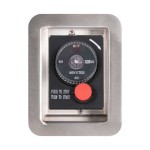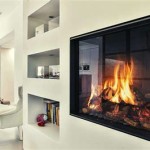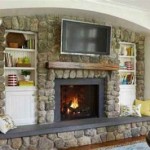Refinishing A Stone Fireplace: A Comprehensive Guide
A stone fireplace is often a focal point in a home, radiating warmth and character. Over time, however, it can become dull, stained, or simply outdated, prompting the need for refinishing. Refinishing a stone fireplace is a process that can breathe new life into this architectural feature, restoring its original beauty or giving it a completely new aesthetic. This endeavor requires careful planning, preparation, and execution to ensure a successful and visually appealing result.
The decision to refinish a stone fireplace may stem from several factors. Discoloration due to soot, smoke, or general grime accumulation is a common issue. Cracks, chips, or crumbling mortar can also necessitate refinishing to maintain the structural integrity and appearance of the fireplace. Furthermore, homeowners may seek to update the fireplace's style to better align with the overall design of their home. Regardless of the motivation, a thorough understanding of the process and the materials involved is crucial.
Assessing the Fireplace and Planning the Refinishing Project
Before embarking on the refinishing process, a comprehensive assessment of the existing stone fireplace is paramount. This involves a detailed inspection of the stone itself, the mortar joints, and the surrounding hearth and mantel. Identifying the type of stone (e.g., fieldstone, river rock, slate, limestone) is essential, as different stone types may require specific cleaning and treatment methods. The condition of the mortar should also be evaluated, noting any areas of cracking, crumbling, or missing mortar. These areas will need to be addressed during the refinishing process.
Once the assessment is complete, a detailed plan should be formulated. This plan should outline the specific goals of the refinishing project, such as cleaning, repairing, staining, painting, or adding a new finish. The plan should also specify the materials and tools required for each stage of the process. Creating a timeline and budget will help ensure that the project stays on track and within financial constraints. Safety precautions should also be considered, including the use of protective gear, proper ventilation, and safe handling of chemicals.
Gathering the necessary materials and tools is a critical step. Depending on the chosen refinishing method, this may include: cleaning agents (e.g., mild soap, stone cleaner, degreaser), masonry brushes, sponges, chisels, hammers, mortar, joint compound, trowels, stone sealers, paints, stains, and protective coatings. Safety equipment such as gloves, goggles, and a dust mask is also essential. Having all the necessary materials readily available will streamline the refinishing process and minimize disruptions.
Preparing the Fireplace for Refinishing
Proper preparation is crucial for achieving a successful refinishing outcome. The first step involves thoroughly cleaning the stone fireplace to remove any dirt, soot, smoke residue, or existing coatings. This can be accomplished using a combination of brushing, vacuuming, and washing with a mild soap solution. For stubborn stains or heavy buildup, a specialized stone cleaner or degreaser may be necessary. It is important to follow the manufacturer's instructions carefully and test the cleaning solution in an inconspicuous area before applying it to the entire surface.
After cleaning, any loose or damaged mortar should be removed. This can be done using a chisel and hammer. Carefully chip away the old mortar, being mindful not to damage the surrounding stones. Once the loose mortar is removed, the joints should be cleaned thoroughly to ensure proper adhesion of the new mortar. A wire brush or a small vacuum can be used to remove any remaining debris.
Protecting the surrounding areas is another important aspect of preparation. Drop cloths or plastic sheeting should be used to cover the hearth, mantel, and any nearby furniture or flooring. This will prevent accidental spills or splatters during the refinishing process. Masking tape can be used to protect trim or other surfaces that need to be kept clean.
Refinishing Techniques: Cleaning, Repairing, and Enhancing
Once the fireplace is properly prepared, the refinishing process can begin. The specific techniques employed will depend on the desired outcome. For simple cleaning and restoration, a stone sealer may be all that is required. Stone sealers are designed to protect the stone from moisture, stains, and other environmental factors. They are available in a variety of finishes, from matte to high-gloss, allowing homeowners to customize the appearance of their fireplace.
Repairing damaged mortar is a common step in the refinishing process. New mortar should be mixed according to the manufacturer's instructions. A trowel is then used to apply the mortar to the joints, filling in any gaps or cracks. The mortar should be packed tightly into the joints and smoothed out to create a uniform surface. Once the mortar has dried, any excess can be removed with a chisel or scraper. It's important to match the color and texture of the new mortar to the existing mortar for a seamless appearance.
For homeowners seeking to update the style of their fireplace, painting or staining the stone may be an option. Before painting or staining, it is important to apply a primer specifically designed for masonry surfaces. This will help the paint or stain adhere properly and prevent it from peeling or chipping. When choosing a paint or stain, select a product that is formulated for use on stone and is resistant to heat and moisture. Consider the overall aesthetic of the room when selecting a color. Earth tones and neutral colors are popular choices for stone fireplaces, but bolder colors can be used to create a more dramatic effect.
Another method to enhance the appearance of a stone fireplace is to apply a thin veneer of new stone. This can be a cost-effective way to give an old fireplace a completely new look without the expense of a full demolition and rebuild. Stone veneers are available in a wide variety of styles, colors, and textures. They are typically installed using a thin-set mortar, and the process is similar to tiling. Veneers can be used to cover the entire fireplace or to create a focal point by adding a decorative border or accent.
Adding a new mantel is another popular way to update the look of a stone fireplace. Mantels are available in a wide range of materials, including wood, stone, and metal. The choice of mantel material will depend on the overall style of the room and the personal preferences of the homeowner. A wooden mantel can add warmth and character, while a stone mantel can create a more modern and sophisticated look. Installation of a mantel typically involves attaching it to the wall above the fireplace opening using screws or bolts.
After any painting, staining, or sealing, allow the fireplace to dry completely and cure according to the manufacturer's instructions. This may take several days or even weeks, depending on the product used. During this time, it is important to avoid using the fireplace and to protect it from moisture and extreme temperatures.
Proper ventilation is essential throughout the refinishing process, especially when working with chemicals or paints. Open windows and doors to allow fresh air to circulate. Consider using a fan to help remove fumes and dust. When working with power tools, wear safety glasses and a dust mask to protect your eyes and lungs.
Maintaining a refinished stone fireplace involves regular cleaning and inspection. Dust and soot should be removed periodically using a soft brush or vacuum. The mortar joints should be inspected for cracks or damage and repaired as needed. Stone sealers should be reapplied every few years to protect the stone from moisture and stains.

Diy Painted Stone Fireplace Refresh Live Edge Mantle Lemon Thistle

How To Painting The Stone Fireplace White Greige Design

How To Paint A Stone Fireplace

How To Paint A Stone Or Brick Fireplace Easy Diy Building Bluebird

See How I Made Over An Ugly Clunky Stone Veneer Fireplace With Paint

Stacked Stone Fireplace Before After A Thoughtful Place

Easy And Affordable How To Paint A Stacked Stone Fireplace Mix Measure Make

Black Painted Fireplace How To Paint Stone

See How I Made Over An Ugly Clunky Stone Veneer Fireplace With Paint

To Paint Or Not Stone Tile Fireplace More








